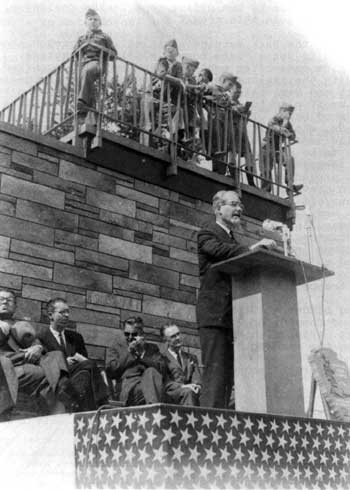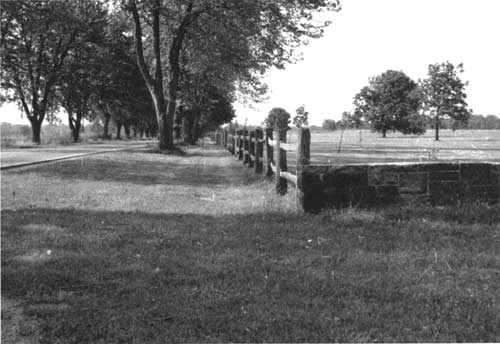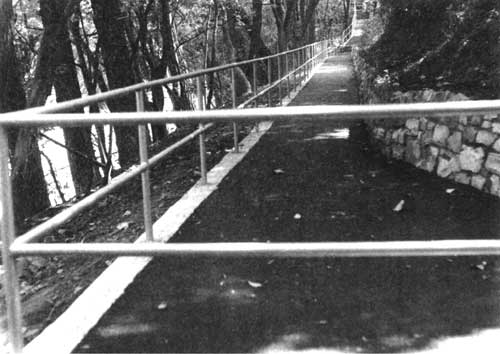Administrative History

|
Hopewell Culture
Administrative History |

|
CHAPTER THREE
Clyde B. King, "Mr. Moundbuilder," 1946-1962 (continued)
| Era of Development: MISSION 66 at Mound City Group |
With disposition to the state of Ohio looming in the mid-1950s, MISSION 66 improvements at Mound City Group National Monument almost did not occur. The February 20, 1956 prospectus arrived with instructions from Associate Director E. T. Scoyen not to undertake any facility development without prior agreement with Ohio. Instead of being placed in a new visitor center/museum, administrative functions were approved for removal from the small office in the superintendent's residence to the shelter house which would be rehabilitated to accommodate this combined purpose. [63]
New attitudes directed toward Mound City Group came in the aftermath of Archeologist John Corbett's early 1956 assessment of significance. A Region Five team conducting an area management study in June 1956, reflected Corbett's views. The team declared the pavilion was poorly sited to serve as the park's visitor center and administration building, and to make it as such would be "pouring good money after bad." They added,
It is our conviction that Mound City Group National Monument should not be subjected to a further interim period of existence. If the decision is to retain it in the National Park System, it should be effectively developed as soon as it can be programmed. If it is to be disposed of, it should be left as it is and immediate steps taken to transfer it. [64]
The team concurred with Clyde King that "undue emphasis" remained on the picnic area with the mounds considered a mere adjunct area for amusement. The monument required a visitor center to "provide proper understanding of the mounds." The team declared, "As a result of our study of Mound City and visits to other mound sites in the vicinity of Chillicothe, we feel that the Monument should be retained as a unit in the National Park System to tell the fascinating story of the Hopewell Indians." If retained, Mound City Group should not only be restored to the prehistoric period, but its title should be changed to convey a more accurate picture to visitors, with a name like "Hopewell Mounds" or "Indian Mounds" National Monument. [65]
In its review and approval of the area management study, Region Five shifted gears and recommended a fundamental revision of the MISSION 66 prospectus. The region concurred with John Corbett concerning national significance, and in assessing the integrity issue, George Palmer stated, "The erection of Camp Sherman did not bring complete destruction of the mounds as we had understood and it appears that the excavations of 1920 and 1921 by the Ohio Archaeological Society was a highly professional project. To us the Mound City Group appears to have higher professional recognition and archeological merit than the National Park Service has credited to it in the past." [66] Therefore, Palmer recommended that the prospectus be altered to include a new visitor center/museum building and parking lot along State Route 104. Such a facility would serve visitors immediately upon their entering the park, would separate primary cultural resources from the public service area, and would constitute an interpretive focus on the mounds themselves. Acknowledging the tardiness of this MISSION 66 proposal, Palmer pressed for its timely consideration. [67]
Although the MISSION 66 prospectus was soon amended to reflect Palmer's request, Director Conrad Wirth's final approval hinged on preparing an acceptable museum prospectus. When a March 1958 draft included plans to use artifacts at the Ohio State Museum, NPS Washington officials wanted a written commitment that the artifacts would be made available upon the visitor center's completion. Acting Director E. T. Scoyen warned, "We believe it would not be proper to program this project without this assurance." [68] When Ohio Historical Society director Erwin C. Zepp agreed to the long-term loan as well as procurement of replicas, [69] planning continued unencumbered.
Public announcement of MISSION 66 improvements came on November 11, 1957. Clyde King reported phase one, fiscal year 1958 improvements of $22,700 in the form of roads, trails, and signs, with $163,200 programmed the following year for the visitor center and utilities. King announced the de-emphasis of Mound City Group as a city picnic area as follows: "The need for a balanced program of cultural preservation at Mound City has not been met. This program will place the interpretation of the Hopewell prehistoric peoples and their culture in its proper perspective and give it the needed emphasis." With new interpretive facilities, King predicted visitation to hit 75,000 by 1966. [70]
Unfortunately, the MISSION 66 program for Mound City Group came in the immediate aftermath of President Dwight D. Eisenhower's speech calling for increased military scientific research spending following the Soviet Union's successful "Sputnik" manned spacecraft launch into Earth's orbit. It prompted a petition circulated by Circleville resident Stewart F. Martin, signed by fifteen other citizens, opposing "spendthrift foolishness" to improve a park already "attractive and highly satisfactory." Directed to their immediate congressional delegation, the petition-signers said only a periodic "fogging" for flies was required, adding, "When we reflect upon the President's recent address and consider the gravity of the current world conditions with the effort and expense of maintaining defense, we cannot afford the luxury of the whimsical desire to put the Hopewell, or any other prehistoric Indians, in the 'proper perspective' or give them their 'needed emphasis.'" [71] In response, Acting Director E. T. Scoyen stated the monument was nationally significant, and as such merited Park Service preservation and interpretation, with development not going beyond the modest amount of $185,900 over a ten-year period. [72] A local drive to drown out the small opposition group effectively mobilized to support park development. [73]
Budget limitation imposed by the Bureau of the Budget eliminated Mound City Group's development funds scheduled for fiscal year 1959. Responding to Ohio Senator Bricker, Acting Director Scoyen said the park held a high priority in the MISSION 66 program and expressed hope that national economic conditions would permit reprogramming and/or scheduling the project. [74] Such a hope sparked to life at mid-year but in reduced form when Director Wirth limited visitor center development to less than $100,000 for building and exhibits. The museum prospectus estimatated space requirements at 4,500 square feet, but to fit funding, planners began reducing the overall space allocation. [75] To King, the reduction in office space still represented more than the existing ten by ten office room in the residence, and he approved space cuts in this area. [76]
Typical of the Park Service's minimalist approach, Mound City Group was to get a "bare bones" MISSION 66 package. Building design came after exhibit planning which occurred in July 1958 with the assistance of Washington Office Archeologist John Corbett and Regional Archeologist John Cotter. The team took their draft plan to Columbus for review by Ohio State Museum curator Raymond Baby. It contained fifteen exhibits to show the use of mounds, who built them and how, and an array of objects the Hopewells used. The plan adopted an existing exhibit and one exhibit was to be seasonal in nature and changed frequently. [77] With funds identified in the fiscal year 1960 budget, King scheduled a project bid-opening for August 18, 1959. Construction drawings called for a one-story stone and brick veneer museum/office building with a panorama bridge deck atop its eastern end. Plans called for a museum surrounding an open-air patio measuring forty by forty feet, with offices, utility room and entranceway facing State Route 104. An outdoor lecture area with steps leading to the panorama bridge faced the mounds and afforded an excellent view of the mound group. A forty-car paved lot to the south was connected via a new road to the existing entrance. [78]
 Figure 34: Region V Archeologist John L. Cotter delivers the keynote speech at the visitor center dedication. (NPS/Mrs. Clyde King, May 14, 1961) |
Winning bidder at $119,334 (not including landscaping), C. A. Yeager and Company of Portsmouth, Ohio, began work on September 21, 1959, with Brewer and Brewer of Chillicothe constructing the roadway. [79] Yeager finished work, including that of a gas and oil house measuring twenty-four square feet, on May 5, 1960. A separate landscaping contract came in late May with work held up until fall because of difficulty in finding the specified flagpole. [80] Limited use of the visitor center came on May 13, 1960, with existing office furniture and exhibits. The new museum displays were installed in early July along with Mound City Group artifacts from the Ohio State Museum. A tentative dedication, planned for early October, was postponed until May 1961, pending finishing touches and selection of an appropriate lead dignitary from Director Wirth's staff. [81]
The most popular visitor service came on August 8, 1960, when speakers were installed on the visitor center's roof and panoramic viewing platform. A recording operated by push-button related the interpretive story of the mounds and the Hopewell culture. It remained available even during the visitor center's after-hours and received very favorable public comment. [82]
Dr. John L. Cotter, regional archeologist, served as keynote speaker at the May 14, 1961, visitor center dedication with Mayor Nicholas H. Holmes the master of ceremonies. Also on the program was James H. Butt, president of the chamber of commerce; Superintendent King; Ross County Historical Society director Eugene D. Rigney; and Ohio Historical Society director Erwin C. Zepp. In his keynote address, Cotter spoke about the park's significance: "Mound City Group is a silent but eloquent testimonial of mankind and his noble effort to honor the past and dedicate himself to the future. It is the story of a people who, from the remote centuries of which we can only surmise a history, draw a living tradition of ceremony to which they devoted some of the finest prehistoric art known to modern man." [83]
Upon completion of the visitor center, several additional MISSION 66 projects were funded. A June 30, 1961, contract provided for modifications to the entrance gate and signage. [84] As part of the Kennedy administration's "New Frontier" public works program in 1963, $85,000 were earmarked to accomplish four Mound City Group projects. First, reforestation "back to the days of Squier and Davis" saw 139 large-sized trees planted along with 1,400 seedlings. Second, workers installed 5,210 feet of split-rail chestnut fencing along the park's north, south, and west boundaries. Third, came an ethnobotanical trail featuring stone walls and a pathway along the Scioto River as well as an interpretive audio station. The fourth and final MISSION 66 project, an earthworks restoration, involved the borrow pits and several other mounds, two of which had never before been opened (see Chapter Four). [85]
 Figure 35: MISSION 66 also saw a chestnut rail fence erected around the monument's boundary; looking north from the entrance road is the new fence along tree-lined Highway 104. (NPS/Richard D. Faust, June 1963) |
 Figure 36: Another MISSION 66 project included construction of an ethnobotanical trail, part of which paralleled the Scioto River. (NPS/John C. W. Riddle, August 1963) |
Superintendent Clyde B. King's sixteen-year tenure at Mound City Group National Monument constituted a period of dramatic change. King arrived in 1946 to find a largely undeveloped park being operated exclusively as a playground. Park visitors, preoccuped by recreational pursuits, had scant knowledge of the prehistoric earthworks. King immediately set to work formulating an interpretive program spending countless hours conducting historical research and utilizing historical society and museum archives in Chillicothe and Columbus. He personally designed and constructed the exhibits in the small museum room, and never missed an opportunity to wax eloquent on the Hopewell culture. Following long-held NPS policy, King worked tirelessly to curtail and nearly eliminate picnicking at Mound City Group. He cultivated allies from within and outside the Park Service to stave-off attempts to turn the park over to the state. King believed strongly in his park and worked tirelessly for it to be transformed from a playground to a legitimate national monument. His dream for Mound City Group was only fulfilled through the auspices of MISSION 66. In his zeal to achieve NPS goals, Clyde King damaged himself in terms of community goodwill and, by extension, caused strained relations with superiors in Philadelphia and Washington, D.C. Nonetheless, King's tribute as "Mr. Moundbuilder" remains legitimate and enduring. Clyde King's strength and vision truly transformed Mound City Group National Monument from a roadside municipal picnic ground into a modern, fully-functional unit of the national park system.
| <<< CHAPTER 2 | TABLE OF CONTENTS | CHAPTER 4 >>> |